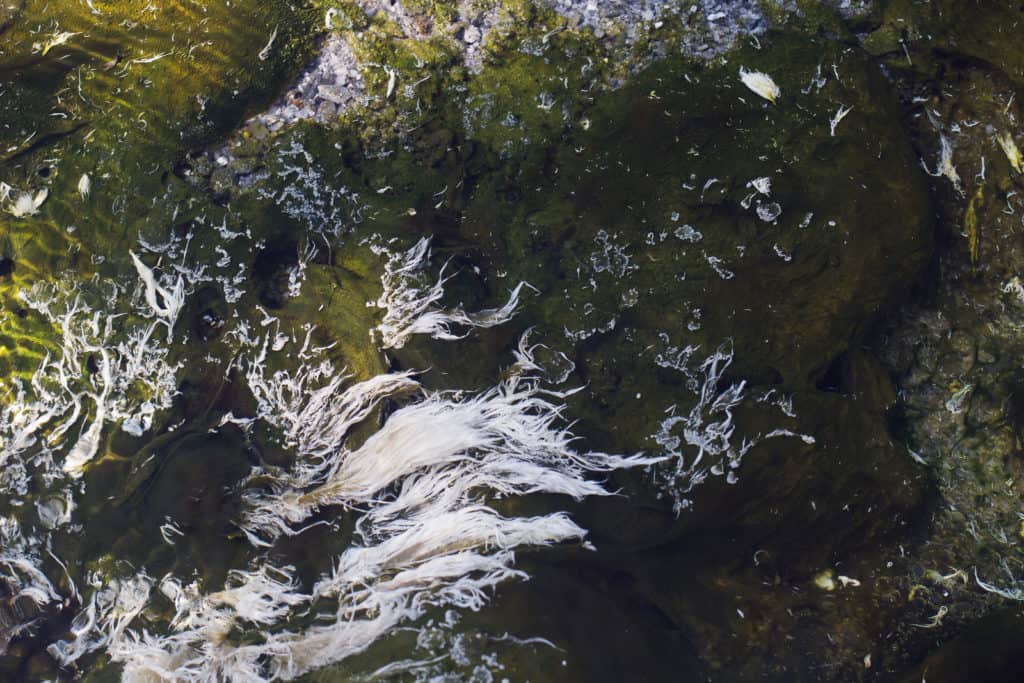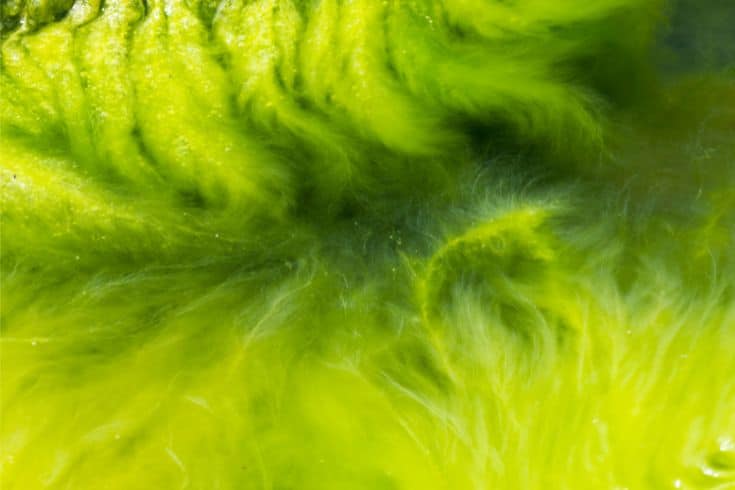White algae can be unsightly and difficult to eliminate if they invade your freshwater aquarium.
So, can you get white hair algae in a saltwater aquarium or reef tank? What causes this stringy problem? And can you prevent white algae from invading your pristine setup?
Read this guide to learn how to identify and get rid of white algae in your fish tank and more!
What Are White Algae?
White algae, or Leptomitus lacteus, belongs to the order Cladophorales that’s closely related to algae in the order Dasycladales. These algae are part of a large, diverse group of simple, chlorophyll-containing organisms that produce energy through photosynthesis.
White algae is actually a species of green hair algae that grows in long, stringy forms, resembling flowing locks of hair. This type of algae is especially difficult to remove since it is very hardy and has a stiff, resistant structure that makes tearing the organism apart very difficult.
Signs of White Algae Growth

White algae grow in long, flowing streamers, attaching themselves to rocks, decorations, plant leaves, and even the substrate.
Causes of White Algae Bloom
There are several common causes of the growth of algae in aquariums, including:
Excess Light
Like most species of algae, white algae does well in a brightly lit tank and loves plenty of natural light.
So, if your fish tank is close to a window, that will make the problem worse.
Incorrect Water pH
The perfect pH level for most fish species is somewhere between 6.5 and 7.5. White algae will begin to grow if pH levels fall outside that range.
Too Many Nutrients
Algae thrive in an environment with high nutrient levels. So, if your tank contains lots of nitrates and phosphates, white algae will quickly take hold and begin to spread.
Poor tank maintenance and a lack of efficient filtration will lead to high levels of ammonia, nitrites, and nitrates in the water, which the algae will love.
Poor Water Flow

Algae love stagnant water, so if your tank doesn’t have adequate circulation, white algae will quickly spread.
Overcrowded Tank
In an overcrowded fish tank, the filter system often cannot cope with the volume of fish waste produced and leftover food. That leads to a build-up of nitrates in the water, providing plenty of food for the algae.
Types of White Algae
There are several types of white algae, and being able to identify them is important since you’ll need slightly different strategies to eradicate them.
Green Hair Algae
Green hair algae usually belong to the genus Oedogonium. These algae are typically green, although white forms are occasionally seen. Hair algae form dense coats of short filamentous growth, creating carpet-like layers over decorations and plants.
Brown Algae
Brown algae is actually a microscopic animal called a diatom rather than algae. This alga forms patches on your decorations, plants, substrate, and aquarium glass. The soft, slimy deposits are easy to remove by gently rubbing them with your finger or a cloth.
Cottony Growth

Cottony growths in your fish tank can usually be attributed to the growth of fungus or mold rather than to algae, although the causes of the problem are effectively the same.
Red Slime Algae
Red Slime algae are actually more correctly known as cyanobacteria, growing as a red, brown, or black slimy coating across rocks and decorations in a saltwater aquarium.
These algae are regarded as the evolutionary link between algae and bacteria and date back at least 3.5 billion years, making them one of the oldest life forms on Earth.
Factors That Contribute To White Algae Growth
Several factors contribute to white algae growth in the aquarium.
Excess Nutrients In The Tank
White algae love high nutrient levels, specifically levels of phosphate and nitrates.
If you have lots of those substances in your aquarium water, it’s likely your filtration system isn’t working efficiently enough for the tank size, or you’re not maintaining your filter properly.
Too Many Hours Of Light Per Day

Algae thrive in brightly lit fish tanks, especially if your aquarium is near a window where it gets a lot of direct sunlight. Alternatively, tanks, where the lights are left on for too many hours per day, tend to be prone to algae growth.
Excess Food or Fish Waste In The Tank
If your aquarium is overcrowded, you might have a problem with excess fish waste and uneaten fish food in the tank.
That organic waste decomposes in the water, placing an increased bioload on your filter system and leading to raised levels of nitrates in the water, which white algae feed on.
Prevention and Treatment Methods For White Algae in Aquariums
You can keep your aquarium clear of all types of algae by following our top tips for its prevention and treatment.
Reduce Hours Of Lighting Per Day
Planted fish tanks need between eight and ten hours of light per day to enable the plants to photosynthesize. Fish also need a clearly defined day/night cycle so that they know when to eat and when to rest.
If you’re not around to manually switch on the aquarium lights, you could invest in an inexpensive timer from your local DIY store. Restricting the lighting hours in your fish tank will discourage algae growth while keeping your aquatic plants and fish happy.
Use A High-Quality Filter To Keep The Tank Clean
All fish tanks should have an efficient aquarium filter installed to keep the water clean and safe for your fish.
The filter contains a range of biological filter media where beneficial nitrifying bacteria can grow. Those bacteria process the ammonia released by decomposing organic matter into nitrites and then into less harmful nitrates.
Without an efficient filter system running, the aquarium water will become toxic and unsafe for your fish, and poor water conditions encourage algae to grow.
Clean The Tank Regularly
You can help to reduce the spread and excess growth of nuisance white algae by keeping the tank clean.
Once a week, use an algae magnet to strip any algae growing on the viewing panes, and periodically scrub your decorations clean.
Use an aquarium vacuum cleaner to remove accumulations of organic waste from deep within the substrate and around the bottom of the tank. That helps to reduce nitrates in the tank, starving algae of the nutrients they need to thrive.
Perform Regular Partial Water Changes
As part of your cleaning regimen, replace around 20 percent of the water in the aquarium with fresh water.
That helps to keep nitrates to a minimum, making the environment healthier for your fish, starving algae, and preventing their growth and spread.
Remove Dead Plant Matter
Decomposing plants and other organic matter produce phosphates, another source of algae nutrients.
Take time to remove dead plant matter every week to keep the environment clean and free from phosphates.
Monitor Phosphate Levels

An important part of your aquarium maintenance routine is monitoring the water’s ammonia, nitrites, nitrates, and phosphate levels.
For your fish to be healthy and to deprive algae of the levels of nutrients they need to thrive, ammonia and nitrites should be zero, and nitrates should ideally be 20 ppm or less.
In reef tanks housing corals, phosphate concentrations should be below 0.02 ppm. Algae tend to thrive in water with phosphate levels of 1 or 2 ppm.
Add More Plants To The Aquarium
Healthy plants use nitrates and phosphates as nutrients, just like algae do, so adding more aquarium plants to your setup can help to effectively starve out the algae and improve your tank’s aesthetics.
Introduce Popular Algae Eaters
Several aquarium inhabitants are known to eat white algae, including barbs, mollies, danios, Siamese Algae eaters, American Flagship, and Chinese Algae Eaters.
If you fancy adding a few invertebrates to keep your aquarium clean and free from algae, Nerite, Sun snails, and Amano shrimp are good choices and make entertaining aquarium pets, too.
FAQs
Here are the answers to some commonly asked questions about white algae.

Q: Are white algae good for aquariums?
A: White algae can look quite attractive in your fish tank until they take over! Generally, the presence of algae in the tank indicates problems with water quality, flow rate, and general husbandry.
So, white algae are not really good for aquariums.
Q: Are white algae harmful to fish?
A: White algae itself is not harmful to your fish. However, its presence in the aquarium can indicate problems with water quality, and that is a problem you must address if your fish are to thrive.
Q: Are white algae harmful to humans?
A: Algae is not generally harmful to humans, although direct contact with it can irritate the eyes, ears, mouth, nose, and skin.
Q: Do snails eat white algae?

A: Some species of snails will graze on white algae. Ramshorn snails, Nerite snails, Malaysian Trumpet snails, and Mystery snails are well known for eating hair algae in freshwater tanks, while Mexican Turbo snails will gobble up white algae in a saltwater tank.
Adding a few algae-eaters to your tank can help to halt the white algae invasion!
Final Thoughts
I hope you enjoyed our guide explaining how to remove and prevent white algae from invading your fish tank. If you did, please take a moment to share it!
White hair algae tend to grow in brightly-lit tanks with poor water quality and plenty of nutrients for the algae to feed on. Keep your tank well-maintained by performing regular water changes and keeping your filter clean and properly maintained.
Add more plants to compete with the algae for nutrients, and include a cleaning crew, including a few algae-eaters, to help keep the white, slimy menace at bay.
What algae eaters did use to help rid your aquarium of white algae? Tell us in the comments box below.
